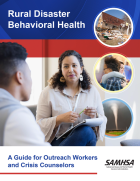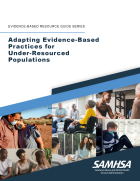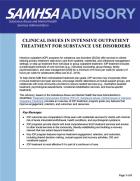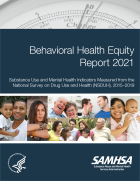This guide provides staff with knowledge and strategies to best support diverse rural communities. It considers risk factors, strengths, and common disaster reactions unique to rural communities to support best practices for ensuring disaster resilience and recovery.
Dashboard: Filter Bricks
Main page content


This guide focuses on research supporting adaptations of evidence-based practices (EBPs) for under-resourced populations. Adaptations involve tailoring care, programs, and services to the cultural, social, gender, and demographic contexts of the people served to yield positive outcomes.

This Advisory, TIP 47, Substance Abuse: Clinical Issues in Intensive Outpatient Treatment, provides an overview of intensive outpatient (IOP) treatment. It discusses typical program goals; outlines key features that improve engagement, retention, and outcomes; and provides additional resources on this critical topic.

This Advisory is based on Technical Assistance Publication (TAP) 21-A, Competencies for Substance Abuse Treatment Clinical Supervisors. It identifies foundational knowledge and concepts essential for supervisory proficiency, roles and skills expected of clinical supervisors, the purpose and context of competencies for supervision in substance use disorder (SUD) treatment programs, and dissemination and implementation of these competencies.

This report provides an update on a series of topics focusing on substance use and mental health (collectively referred to as behavioral health) in the United States. SAMHSA selected specific topics and indicators in this report to represent a cross-section of the key behavioral health indicators that are assessed in SAMHSA data collections, including NSDUH. This report is intended to provide a concise, reader-friendly summary of key behavioral health measures for lay and professional audiences.

The EAP Prescription Drug Toolkit and Fact Sheets provide guidance related to counseling, referrals, and follow-up services (e.g., alternatives to prescription drugs, workplace drug misuse and relapse prevention, dangers of combined drug use, screenings, and evaluations before returning to work).

The report discusses Medicaid coverage of FDA-approved medications for treatment of alcohol and opioid use disorders, limitations on coverage (such as prior authorization requirements), background on federal laws and policies and innovative practices and policies at the state level.

This quick guide contains an overview of the challenges associated with tobacco cessation and the benefits of being tobacco-free for individuals as well as those of a smoke-free workplace. It also includes tips that substance use disorder treatment settings can use to implement their own tobacco cessation programs.

This pamphlet offers reasons to combine tobacco cessation and substance use disorder treatment, including client testimonials and resources for implementing a tobacco cessation program. It also explains the benefits of offering tobacco cessation programs in substance use disorder treatment settings.

Provides behavioral health, correctional, and community stakeholders with examples of the implementation of successful strategies for transitioning people with mental or substance use disorders from institutional correctional settings into the community. Highlights prevalence of mental and substance use disorders in correctional settings.
Displaying 1 - 10 out of 38

